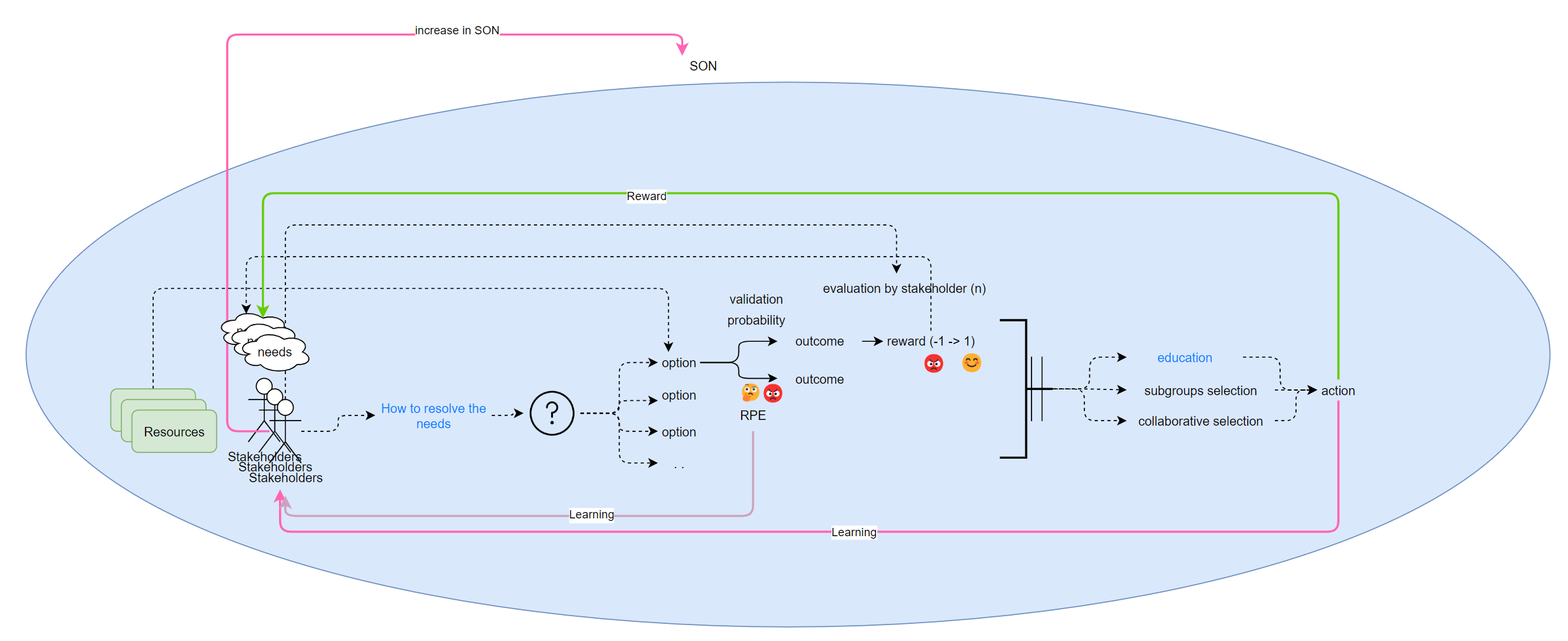Mechanistic Model for Decision Making
This theory introduces a mechanistic model that delineates the intricate cognitive processes involved in decision-making. Drawing from psychological and epistemological perspectives, the proposed model elucidates the interplay of various mental elements during the decision-making process. The components include the identification of needs, consideration of stakeholders, formulation of questions, generation of options, and the subsequent evaluation, selection, and implementation of decisions. Furthermore, the model incorporates the concept of a Mental Objects Network (MON) to elucidate the role of interconnected theories in shaping decision outcomes. The paper underscores the importance of resource analysis, value attribution to outcomes, and the nuanced consideration of probability in optimizing decision outcomes. Additionally, it explores the influence of familiarity and external factors on decision selection, emphasizing the role of learning in the development of a corroborated System of Neural (SON) essential for better predictions.
Decision-making is a multifaceted cognitive process involving intricate mental elements that synergistically contribute to the formulation of choices. This paper presents a comprehensive mechanistic model that elucidates the underlying cognitive mechanisms governing decision-making.
Contents
Elements
Need Identification
The decision-making process commences with the identification of needs, representing a biological signaling process within the brain, indicating a lack of essential resources. These resources can manifest in both physical and emotional domains, aligning with established psychological paradigms such as Maslow's hierarchy of needs.
Stakeholders
Stakeholders, encompassing both organizational members and external entities, play a pivotal role in decision-making by virtue of being potential recipients of the consequences stemming from organizational actions. A thorough understanding of stakeholders and their interests informs the decision-making process.
Question formulation
Questions serve as cognitive tools facilitating information gathering and initiation of the decision-making process. The formulation of relevant queries directs the subsequent exploration of potential solutions to address identified needs.
Options
The decision space is delineated by the generation of options, each representing a potential avenue for fulfilling identified needs. These options, when meticulously analyzed, form the basis for subsequent evaluation and selection.
Mental Objects Network
The proposed model introduces the concept of a Mental Objects Network (MON) to elucidate the interconnected nature of theories within the brain. The MON, comprised of mental objects representing our understanding of the world, plays a crucial role in shaping decision outcomes.
For further explanation, see epistemology.
Outcomes Analysis
Every option culminates in specific outcomes, each carrying a distinct value that may range from rewarding to taxing. The theory emphasizes the need for a nuanced evaluation of these outcomes to inform decision-making.
Resources
Every option consumes resources, necessitating a consideration of available resources when evaluating options. Resource analysis is integral to the decision-making process, as each option consumes resources. A judicious consideration of available resources is essential in assessing the feasibility and sustainability of potential decisions.
Value
Outcomes have varying values, ranging from rewarding to neutral or taxing, affecting our physical and emotional resources. Each stakeholder has different resources and values, which affect the value of each option.
Probability of success
he probability of success is a critical factor influencing decision-making. Each option, constructed as a cascade of events, carries varying probabilities of success. The theory should relate to the nuances of probability estimation, including known probabilities and the level of corroboration through testing theories.
Resources
For every action, which is based on the option we selected, there is a tax on our resources. Before we evaluate options, we should also consider how much resources do we have, and if we have the specific resources needed for the option.
Evaluation
When faced with a selection of options, it is important to conduct a comprehensive assessment of the overall outcome benefits, necessary resources, and likelihood of success. Each stakeholder may evaluate the return on investment (ROI) of each option based on their individual needs and resources, which may differ from those of other stakeholders.
Selection
Optimal decision-making involves comparing the total value of each option and choose the one with the highest value. External factors may influence decision-making, such as familiarity with an option, even if better alternatives exist.
Selection involves the comparison of available options and selecting the one that provides the best value. However, for various reasons that we will discuss later, we may not evaluate all options or choose the one we are more familiar with, even if there are better options available. The process of selecting an option is also known as making a decision.
Action
To improve decision-making, every selection should be followed by actions designed during the selection phase. This will help the group learn from experience and improve their SON.
Learning
Learning is a continuous process involving hypothesis formulation and testing.
Decision-making and practical experiences contribute to the development of a corroborated System of Neural (SON), forming the basis for accurate predictions.
Learning occurs through personal experiences, testing theories, and considering insights from others. (see Karl Popper on terminology[1]).
See also
References
- ↑ Popper, K. (2002). The Logic of Scientific Discovery (Routledge Classics). Routledge.
